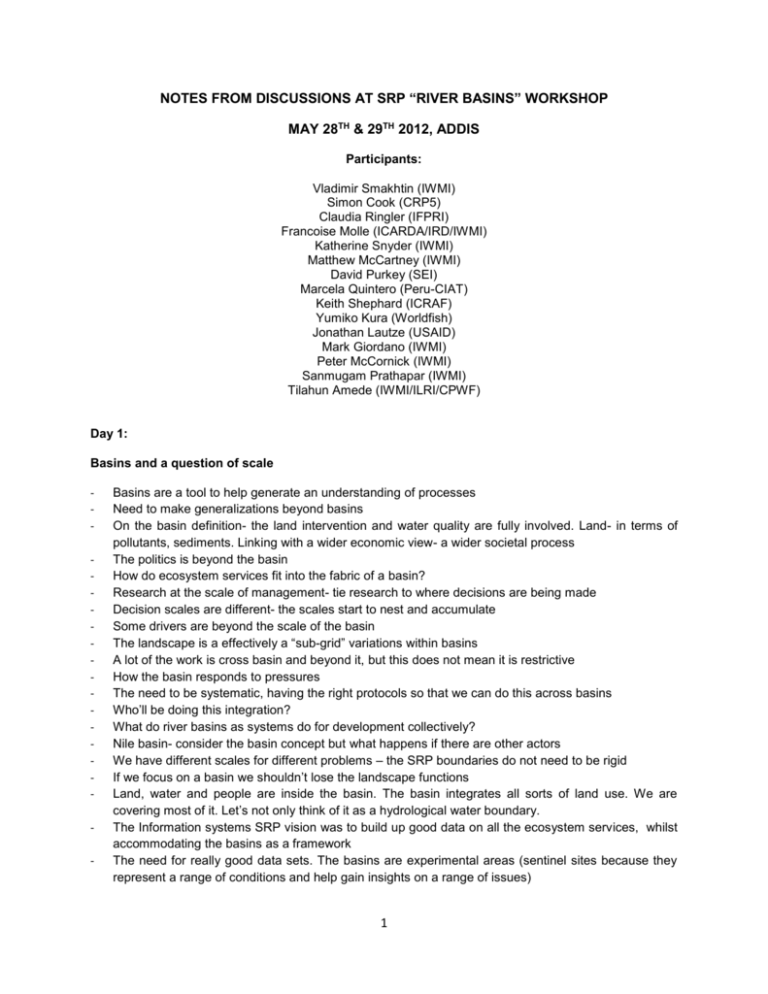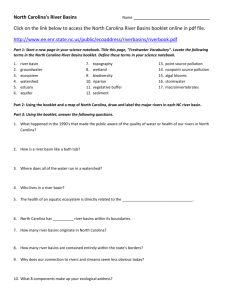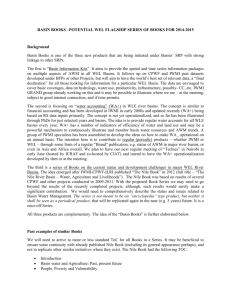SRP River Basins_ Summary document
advertisement

NOTES FROM DISCUSSIONS AT SRP “RIVER BASINS” WORKSHOP MAY 28TH & 29TH 2012, ADDIS Participants: Vladimir Smakhtin (IWMI) Simon Cook (CRP5) Claudia Ringler (IFPRI) Francoise Molle (ICARDA/IRD/IWMI) Katherine Snyder (IWMI) Matthew McCartney (IWMI) David Purkey (SEI) Marcela Quintero (Peru-CIAT) Keith Shephard (ICRAF) Yumiko Kura (Worldfish) Jonathan Lautze (USAID) Mark Giordano (IWMI) Peter McCornick (IWMI) Sanmugam Prathapar (IWMI) Tilahun Amede (IWMI/ILRI/CPWF) Day 1: Basins and a question of scale - Basins are a tool to help generate an understanding of processes Need to make generalizations beyond basins On the basin definition- the land intervention and water quality are fully involved. Land- in terms of pollutants, sediments. Linking with a wider economic view- a wider societal process The politics is beyond the basin How do ecosystem services fit into the fabric of a basin? Research at the scale of management- tie research to where decisions are being made Decision scales are different- the scales start to nest and accumulate Some drivers are beyond the scale of the basin The landscape is a effectively a “sub-grid” variations within basins A lot of the work is cross basin and beyond it, but this does not mean it is restrictive How the basin responds to pressures The need to be systematic, having the right protocols so that we can do this across basins Who’ll be doing this integration? What do river basins as systems do for development collectively? Nile basin- consider the basin concept but what happens if there are other actors We have different scales for different problems – the SRP boundaries do not need to be rigid If we focus on a basin we shouldn’t lose the landscape functions Land, water and people are inside the basin. The basin integrates all sorts of land use. We are covering most of it. Let’s not only think of it as a hydrological water boundary. The Information systems SRP vision was to build up good data on all the ecosystem services, whilst accommodating the basins as a framework The need for really good data sets. The basins are experimental areas (sentinel sites because they represent a range of conditions and help gain insights on a range of issues) 1 - We need to try to find sub categories within the basin SRP under which different institutes and groups can formulate their projects. Boundaries between SRPs will have to be loose, as the current SRP structure is far from ideal Need for sub SRPs (e.g. CCAFS)- sub categorization will be necessary but that’s just logistics There are no major contradictions. Different problems have their own scales and integrating this into the SRP is a different issue. What’s the expected impact of the research? - Impact - start from the notion of what problem you want to resolve? We need exciting science indicators- need to know how we want to be evaluated Data If there’s a general need for data, what is the strategy? Need to look at what problem we’re going to solve and what data you need to do that Is it a gap that’s necessary to solve that problem? Can we fill the data through another approach? Data is driven by the problem that needs to be solved Provide protocols to keep data archived in a consistent way (putting them together and sharing How do we make sure that the data doesn’t get lost? The problem within the CG /IWMI- unlimited types of data New ways needed - technologies to measure things from space. We need to link with big players, universities, ground observations are not developing. Strength of CG- capacity to implement a standard set of measurements Trying to develop national capacity for surveillance systems In some cases you collect data and look for application afterwards Failure that the data couldn’t be translated, instruments couldn’t be put in place Use of crowd sourcing e.g. Bangalore- t-shirts with censors to measure air quality o This works for some areas not others o Its trickier for soils and water o Helps for air pollution monitoring and human disease outbreaks- depends a lot on the topic Use of mobile phones Nano technology Water quality kits being given to schools- data is reported For developing countries it’s the community based measurements of things such as water that can be implemented Research questions themselves- local villagers collecting data (the issue is collecting data more into the public domain) ICRISAT’s group- community based drought monitoring There’s more socio economic data that’s being shared now Other - The CRPs are pro poor and more development oriented People are also part of the solution, not just the problem. How can improve development pressures to respond to both demands of the sustainable resource use but is also equitable? Lack of good data (lack of being able to measure things which makes managing these resources difficult) 2 - - Integrated gender, poverty and equity at the beginning of a project rather than trying to understand the impacts afterwards The use of economic tools analysis How can the models fit? Data collection and setting up protocols that can be used across the board o Stakeholder platforms – giving them a voice remains a challenge. If done right helps with equity and basin decisions will be more accepted How can we incorporate the voices of farmers and the poor with regards to basin decisions? Day 2: Ecosystem services: - Ecosystem services is a huge trend along with the attempt to quantify its metrics and monitor the impact o Nobody can translate it- they’re difficult to quantify and lack understanding. Research is being done to show this can be built into the decision making process o Link ecosystem services with poverty alleviation o Ecosystem services,-not only ecosystem services per se but all the benefits, hydropower, irrigation,etc. What are the economic benefits for that particular ecosystem service? How can these economic benefits be better shared? What is the ecosystem service that is being valued? Can we quantify or analyze the collective use of ecosystem services? Can this be done through total factor productivity? Corruption in the water sector - This needs to be defined broadly from the development side as well to include government structures and the actual impact of corruption Perhaps one area to analyze would be reverse impact on uptake because of the corruption in the private sector Can this be tied into FDI? - The other element of this corruption is around infrastructure and FDI What insight can be provided to improve the outcome when looking at intensification? Perverse incentives Technology development trends - Biofuel development- there was a spike in 2009 in terms of investments in developing countries but that’s still growing Competition for fuel and food Land grabbing- particularly in Africa- stats on the extent of buying up of land (FDI) o We need to have a broader focus rather than fragment Trend in Latin America- signature of free trade agreements with developed countries. This will change agriculture in basins. This is now a reality. It’s another scenario of change in basin strategy Mining is growing fast- gold, silver, they use a lot of water and pollute the water Massive urbanization trends that can change landscapes 3 - Doubling of food production of large private farms and smallholders forming cooperatives The future of what production is on farms and not from forests. Increase of tree products from farming systems- this will affect water We talk a lot of these changes and what’s happening. Can we start thinking about reporting on these? Mapping and the use of water on these changing landscapes. Not only internally but also for external use Governance- differentiating it from the other SRPs. o How can we improve participation? Think about what scale of governance and institutions actually works and what doesn’t? o Are the basin organizations actually effective? Do they do something effective? At what scale should we be designing these? Are there problems in basin science/management that can be eradicated completely in the next 5-10 years? Problems that are close to resolution? - Vulnerability to drought through a combination of system selection- structural measures, insurance etc that could give you short wins Many cropping systems underperform to manage drought risk. There are opportunities in livestock systems, opportunistic cropping- good area to work with CRP7 Could we say we have a baseline evaluation of ecosystem services in the major basins of developing countries? In 5 years could we have a baseline that has moved to ecosystem services? Baseline and how the baseline could change given the different scenarios of change Research interaction- dialogue with people who live and govern the basins Develop protocols for monitoring and evaluation and demonstrate this in the river basins- this might be an impetus to develop a common framework Action items: - Look at how do different activities relate to SLOs Work out the process of face to face SRP meetings in the future Establish working groups as needed Communicate with the centers who are absent and update them on the discussions and developments that occurred during the workshop 4




